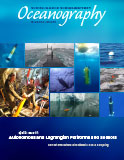Article Abstract
As autonomous sampling technologies have matured, ocean sensing concepts with long histories have migrated from their traditional ship-based roots to new platforms. Here, we discuss the case of ocean microstructure sensing, which provides the basis for direct measurement of small-scale turbulence processes that lead to mixing and buoyancy flux. Due to their hydrodynamic design, gliders are an optimal platform for microstructure sensing. A buoyancy-driven glider can profile through the ocean with minimal vibrational noise, a common limitation of turbulence measurements from other platforms. Moreover, gliders collect uncontaminated data during both descents and ascents, permitting collection of near-surface measurements unattainable from ship-based sensing. Persistence and the capability to sample in sea states not feasible for deck-based operations make glider-based microstructure sampling a profoundly valuable innovation. Data from two recent studies illustrate the novel aspects of glider-based turbulence sensing. Surface stable layers, characteristic of conditions with incoming solar radiation and weak winds, exemplify a phenomenon not easily sampled with ship-based methods. In the North Atlantic, dissipation rate measurements in these layers revealed unexpected turbulent mixing during times of peak warming, when enhanced stratification in a thin layer led to an internal wave mode that received energy from the deeper internal wave field of the thermocline. Hundreds of profiles were obtained in the Bay of Bengal through a barrier layer that separates a strongly turbulent surface layer from a surprisingly quiescent interior just 20 m below. These studies demonstrate the utility of buoyancy-driven gliders for collecting oceanic turbulence measurements.

